Learning Objectives
- Identify reasons for the use of MLA formatting and documentation
- Identify MLA document formatting, including page layout
- Identify the components of MLA Works Cited citations
- Identify the components of MLA in-text citations
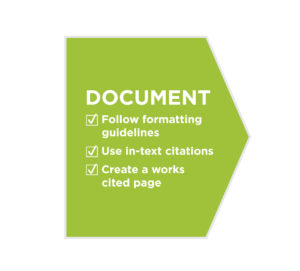
Figure \(\PageIndex{1}\) - Checklist for documenting sources.
“MLA” stands for Modern Language Association. This is a professional organization for scholars of language and literature.
But why does this group of people have so much influence on the appearance of papers you write in college?
The MLA, like many other academic organizations, publishes a scholarly journal and has done so for decades. In years before computers were common, the editors of this journal required typed submissions for publication to follow a common formatting template.
The professors who were following this format to write their own work recognized the value of having some standard of uniform appearance. They started asking their students to follow the same format when they typed essays for class projects.
Fast forward to now, and we have a thick set of guidelines for how the first page of an essay should look, what margins and font are appropriate, and what a Works Cited entry for a blog post should look like.
The ultimate goal for MLA formatting and citation standards is so that everyone has a common template to draw from. While they may feel like unbreakable rules, try to remember that they were created to serve a common need, with your interests in mind.
Overview of MLA Documentation
MLA style is one of the most common citation and formatting styles you will encounter in your academic career. Any piece of academic writing can use MLA style, from a one-page paper to a full-length book. It is widely used by in many high school and introductory college English classes, as well as scholarly books and professional journals. If you are writing a paper for a literature or media studies class, it is likely your professor will ask you to write in MLA style.
The importance of using citations is explained in the following video:
The Purpose of MLA Style
The MLA style guide aims to accomplish several goals:
- to ensure consistent use of the English language in academic writing;
- to ensure consistent formatting and presentation of information, for the sake of clarity and ease of navigation; and
- to ensure proper attribution of ideas to their original sources, for the sake of intellectual integrity.
CITATION RESOURCES
There are many fantastic resources out there that can make the formatting and citation process easier. Some common style guides are found at:
- The Purdue Online Writing Lab: this is a popular resource that concisely explains how to properly format and cite in various academic styles.
- EasyBib: in addition to having a style guide, this website allows you to paste in information from your research and will create and save citations for you.
Reference management websites and applications can also assist you in tracking and recording your research. Most of these websites will even create the works cited page for you! Some of the most popular citation tools are:
The New Edition
The newest edition of the MLA Handbook, the 8th Edition, was released in April 2016. This text will focus on the newest changes, but you should be aware that some institutions or instructors may still utilize the previous 7th edition of the handbook. While the overall principles of creating a works cited page and using in-text citations remains the same, there are a few key changes and updates that make the citation process easier for our modern uses. For example, the guidelines now state that you should always include a URL of an internet source, you can use alternative author names, such as Twitter handles, and you no longer need to include the publisher (in some instances), and you don’t need to include the city where a source was published. These new changes are less nit-picky and allow for a more streamlined citation process that will work with the wide variety of source locations (i.e., YouTube videos, songs, clips from TV episodes, websites, periodicals, books, academic journals, poems, interviews, etc.).
Overall Structure of an MLA Paper
Your MLA paper should include the following basic elements:
- Body
- (If applicable) Endnotes
- Works Cited
Example \(\PageIndex{1}\):
Visit the Modern Language Association website to see an example of a student paper following MLA guidelines.
- Font: Your paper should be written in 12-point text. Whichever font you choose, MLA requires that regular and italicized text be easily distinguishable from each other. Times and Times New Roman are often recommended.
- Line Spacing: All text in your paper should be double-spaced.
- Margins: All page margins (top, bottom, left, and right) should be 1 inch. All text should be left-justified.
- Indentation: The first line of every paragraph should be indented 0.5 inches.
- Page Numbers: Create a right-justified header 0.5 inches from the top edge of every page. This header should include your last name, followed by a space and the page number. Your pages should be numbered with Arabic numerals (1, 2, 3…) and should start with the number 1 on your title page. Most word-processing programs have the ability to automatically add the correct page number to each page so you don’t have to do this by hand.
- Use of Italics: In MLA style, you should italicize (rather than underline) the titles of books, plays, or other standalone works. You should also italicize (rather than underline) words or phrases you want to lend particular emphasis—though you should do this rarely.
- Sentence Spacing: Include just one single space after a period before the next sentence: “Mary went to the store. She bought some milk. Then she went home.”
- The first page: Like the rest of your paper, everything on your first page, even the headers, should be double-spaced. The following information should be left-justified in regular font at the top of the first page (in the main part of the page, not the header):
- on the first line, your first and last name
- on the second line, your instructor’s name
- on the third line, the name of the class
- on the fourth line, the date
- The title: After the header, the next double-spaced line should include the title of your paper. This should be centered and in title case, and it should not be bolded, underlined, or italicized (unless it includes the name of a book, in which case just the book title should be italicized).
- The Oxford Comma: The Oxford comma (also called the serial comma) is the comma that comes after the second-to-last item in a series or list. For example: The UK includes the countries of England, Scotland, Wales, and Northern Ireland. In the previous sentence, the comma immediately after “Wales” is the Oxford comma. In general writing conventions, whether the Oxford comma should be used is actually a point of fervent debate among passionate grammarians. However, it’s a requirement in MLA style, so double-check all your lists and series to make sure you include it!
Watch this video to review all of the basic formatting recommendations:
In MLA style, all the sources you cite throughout the text of your paper are listed together in full in the Works Cited section, which comes after the main text of your paper.
- Page numbers: Just as the rest of your paper, the top of the page should retain the right-justified header with your last name and the page number.
- Title: On the first line, the title of the page—“Works Cited”—should appear centered, and not italicized or bolded.
- Spacing: Like the rest of your paper, this page should be double-spaced and have 1-inch margins (don’t skip an extra line between citations).
- Alphabetical order: Starting on the next line after the page title, your references should be listed in alphabetical order by author. Multiple sources by the same author should be listed chronologically by year within the same group.
- Hanging indents: Each reference should be formatted with what is called a hanging indent. This means the first line of each reference should be flush with the left margin (i.e., not indented), but the rest of that reference should be indented 0.5 inches further. Any word-processing program will let you format this automatically so you don’t have to do it by hand. (In Microsoft Word, for example, you simply highlight your citations, click on the small arrow right next to the word “Paragraph” on the home tab, and in the popup box choose “hanging indent” under the “Special” section. Click OK, and you’re done.)
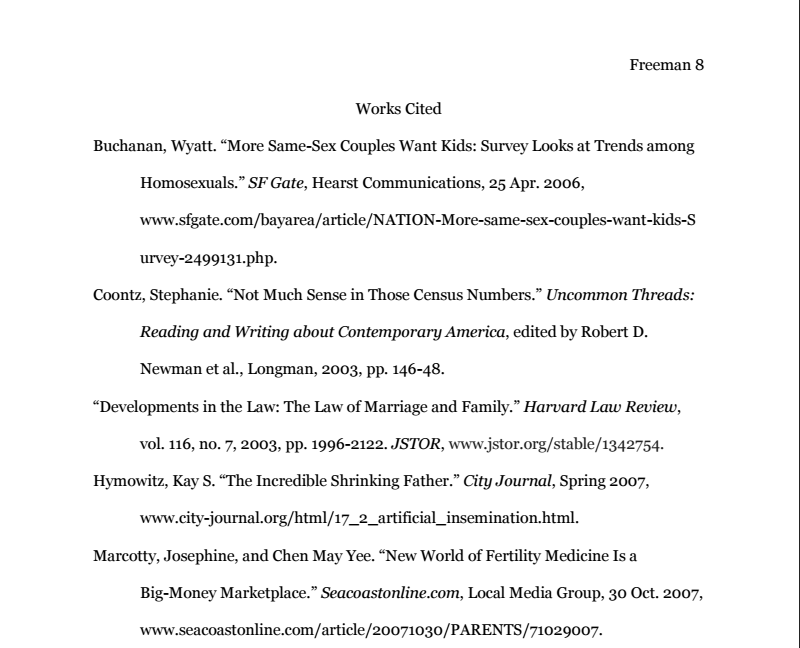
Figure \(\PageIndex{2}\)
Creating Works Cited Entries
Although there are still distinct rules you need to follow to create a citation, the rules in MLA 8 are less rigid than before and allow for you to look for the main components of a citation and construct it yourself. This means you will need to think about the source and its information, select the appropriate components, and organize it in a logical and useful manner.
Regardless of the source type, you are now asked to locate the same “core elements” from your sources and place them in a standard order in order to create citations. These core elements are explained in detail below. Note that you do not need to memorize every step of this process, but should take this opportunity to understand how citations are created. You can always return to this page, to the MLA handbook, or to online resources to help you create the citations you need for your paper.
Click through the following slides to learn more about each component and to see examples of MLA citations.
You can also download the presentation here.
Click on the image below to take you to a video explanation on how to identify the core elements of a citation.
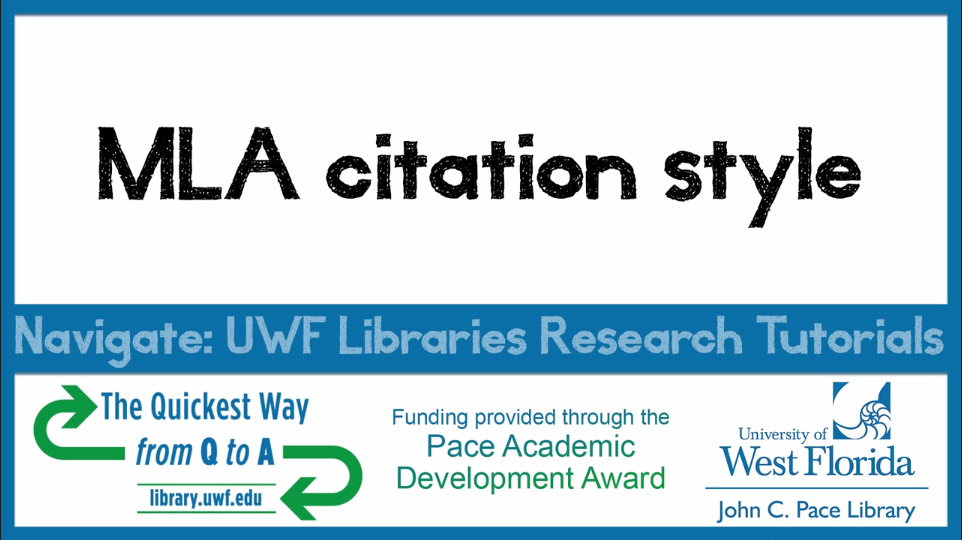
Figure \(\PageIndex{3}\)
MLA 8th edition – UWF from Joshua Vossler on Vimeo.
In-Text Citations
In your paper, when you quote directly from a source in its words, or when you paraphrase someone else’s idea, you need to tell the reader what that source is so the author gets credit. When you tell the reader the author’s name in the text of your paper, this is called an in-text citation.
In-Text citations are placed in parentheses, and have two components:
- The first word found in the full citation on the Works Cited page (usually the last name of the author)
- The location of the direct quote or paraphrase (usually a page number)
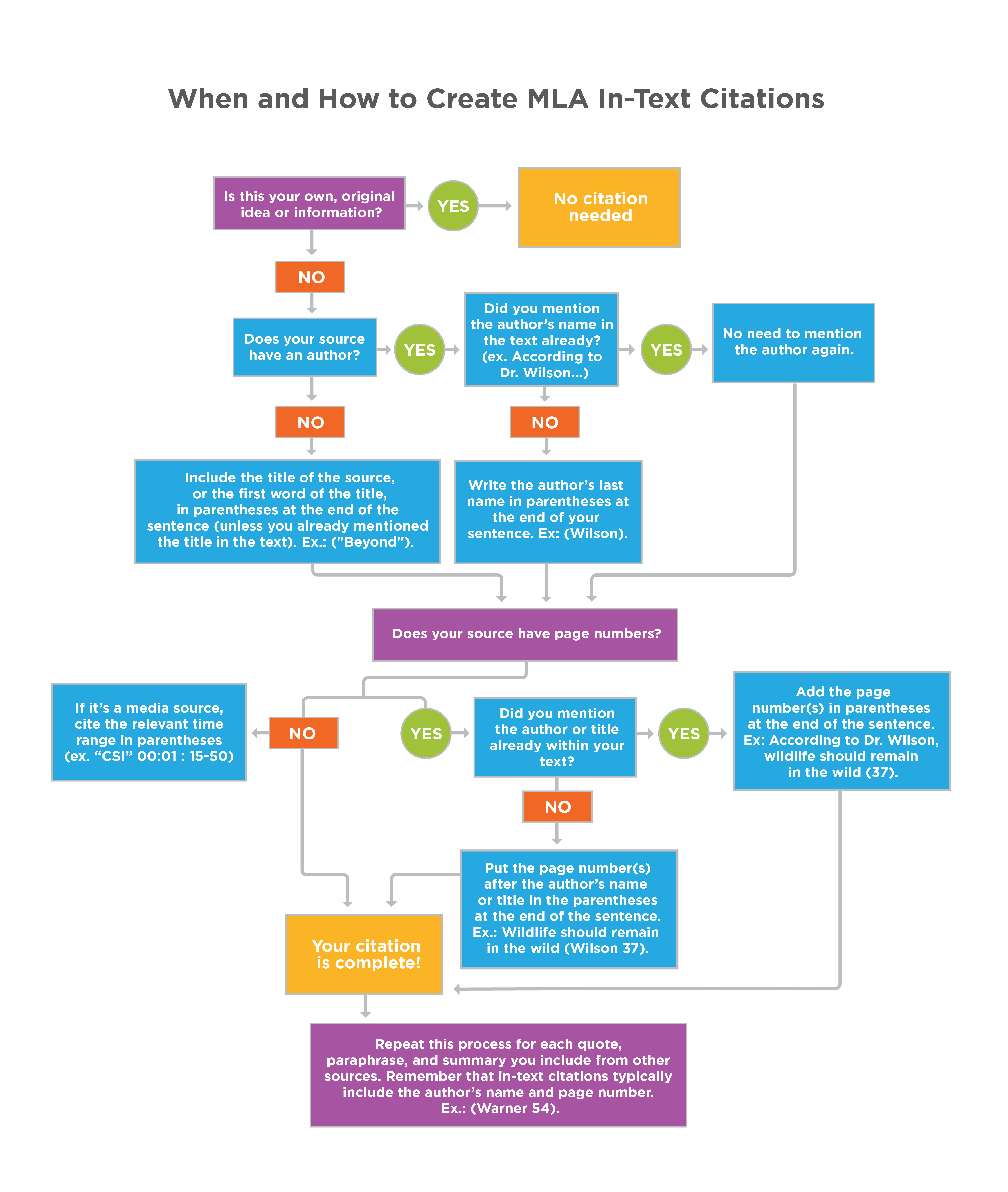
Figure \(\PageIndex{4}\)
In-Text citations should be placed directly after the direct quote or paraphrase, or in a place that is a natural pause and does not cause the reader to become distracted while reading the body of your work.
Example \(\PageIndex{3}\):
In order to prevent starvation, Watney knew exactly what he needed to do. “My best bet for making calories is potatoes” (Weir 17).
When using the author’s name in the sentence, only include the page number in the parentheses.
Example \(\PageIndex{4}\):
Seuss’s use of words such as “lurk” and “dank” help students understand the type of character that the Once-ler is (6).
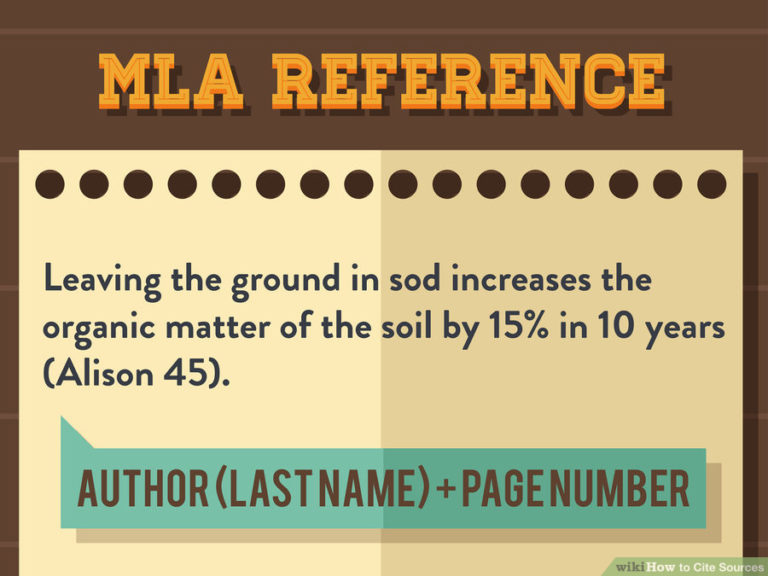
Figure \(\PageIndex{5}\) - Write author (last name) and page number in parentheses. If the author is already mentioned in the statement, just put the page number in parentheses. If there are two authors, name them both with “and” in the middle. Use commas if there are more than two authors. Place the citation before a punctuation mark. E.g. Leaving the ground in sod increases the organic matter of the soil by 15% in 10 years (Alison 45).
When to Use a Block Quotation
A typical quotation is enclosed in double quotation marks and is part of a sentence within a paragraph of your paper. However, if you want to quote more than four lines of prose (or three lines of verse) from a source, you should format the excerpt as a block quotation, rather than as a regular quotation within the text of a paragraph. Most of the standard rules for quotations still apply, with the following exceptions: a block quotation will begin on its own line, it will not be enclosed in quotation marks, and its in-text citation will come after the ending punctuation, not before it. It should be indented one inch from the left margin.
Example \(\PageIndex{5}\):
For example, if you wanted to quote the entire first paragraph of Lewis Carroll’s Alice in Wonderland, you would begin that quotation on its own line and format it as follows:
Alice was beginning to get very tired of sitting by her sister on the bank, and of having nothing to do: once or twice
she had peeped into the book her sister was reading, but it had no pictures or conversations in it, ‘and what is the
use of a book,’ thought Alice, ‘without pictures or conversations?’ (Carroll 98)
The full reference for this source would then be included in your Works Cited section at the end of your paper.






